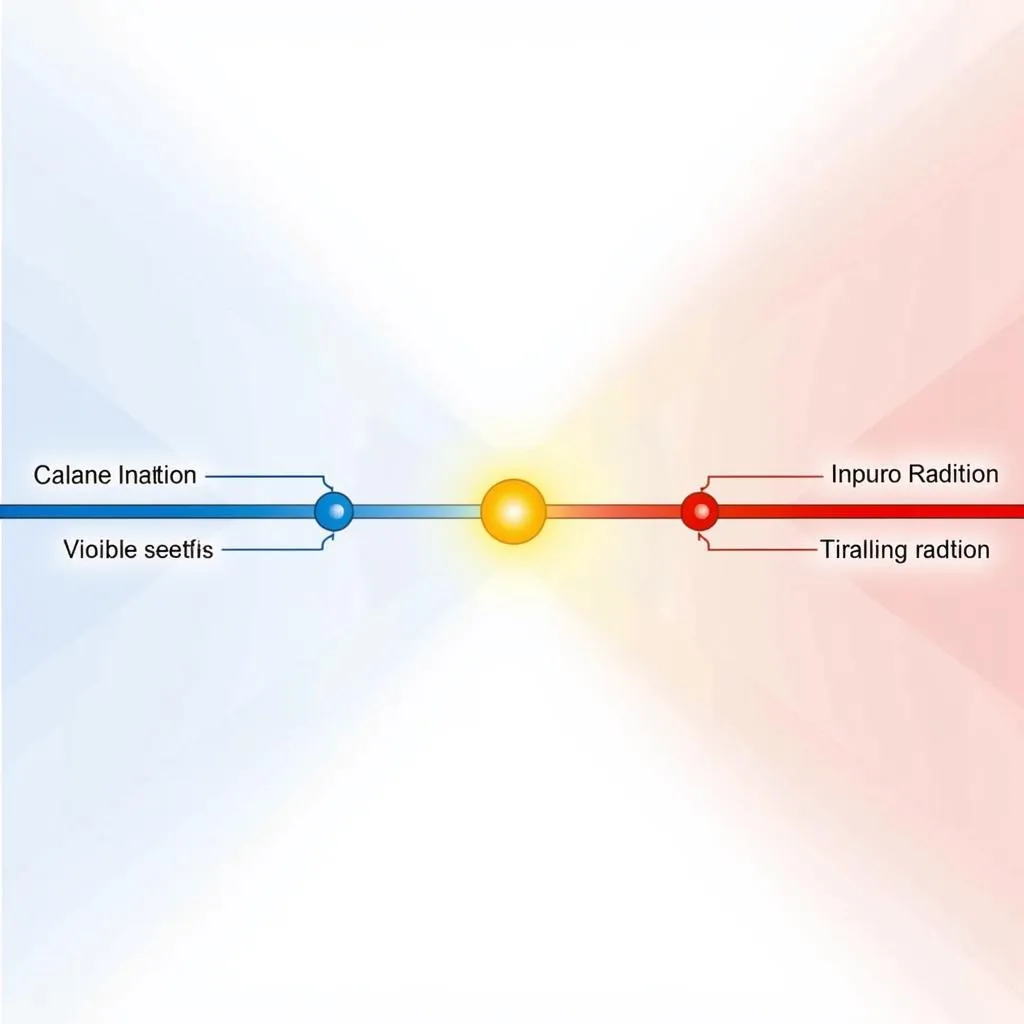Have you ever gazed at a rainbow and wondered, “Are there infinite colors?” It’s a question that has captivated artists, scientists, and curious minds for centuries. While our eyes can only perceive a limited range of the electromagnetic spectrum, the world of color is vast and full of surprises. Let’s delve into the fascinating realm of color and uncover the truth behind this intriguing question.
The Science Behind Color Perception
To understand the concept of infinite colors, we need to first grasp how we perceive them. Color is not an inherent property of objects but rather a result of how our eyes and brain interpret light waves. When light hits an object, some wavelengths are absorbed while others are reflected. Our eyes detect these reflected wavelengths and send signals to the brain, which then interprets them as different colors.
 Human Eye Perceiving Light Waves
Human Eye Perceiving Light Waves
The human eye has three types of color receptors, called cones, each sensitive to a different range of wavelengths: red, green, and blue. These primary colors combine in countless ways to create the spectrum of colors we see. By adjusting the intensity and proportion of these primary colors, we can create millions of different shades and hues.
The Limits of Human Vision
While the possibilities seem endless, human vision has its limitations. We can only perceive a small portion of the electromagnetic spectrum, known as visible light. This visible spectrum ranges from violet, with the shortest wavelength, to red, with the longest. Beyond these limits lie ultraviolet (UV) and infrared (IR) radiation, which are invisible to the naked eye.
 Electromagnetic Spectrum with Visible Light Highlighted
Electromagnetic Spectrum with Visible Light Highlighted
This means that even within the visible spectrum, there may be colors that we cannot perceive. Some animals, like birds and insects, have additional color receptors that allow them to see ultraviolet light, opening up a whole new world of colors beyond our comprehension.
The Illusion of Infinity
So, are there infinite colors? From a purely mathematical perspective, the answer could be yes. Within the visible spectrum, we can theoretically create an infinite number of color variations by subtly adjusting the wavelengths and intensities of light.
However, our ability to distinguish these subtle differences is limited by the sensitivity of our eyes and brain. At some point, the variations become too small for us to perceive as distinct colors. Therefore, while the potential for infinite colors may exist, our experience of color is finite.
Exploring the Color Wheel
A helpful tool for understanding color relationships and mixing is the color wheel. It arranges primary, secondary, and tertiary colors in a circular format. By understanding color theory and the principles of color harmony, you can create visually appealing and balanced color palettes for your home or creative projects.
- Primary Colors: Red, yellow, and blue form the foundation of the color wheel and cannot be created by mixing other colors.
- Secondary Colors: Orange, green, and violet are created by mixing two primary colors.
- Tertiary Colors: Mixing a primary color with a neighboring secondary color creates tertiary colors like red-orange and blue-green.
Learning how to mix these colors opens up a world of possibilities. For example, did you know that you can mix purple color paint by combining red and blue? Or that orange is a result of mixing what two colors mixed together make orange? Understanding these basic principles allows you to create any color imaginable.
The Subjectivity of Color
Adding another layer of complexity is the subjective nature of color perception. Factors like cultural background, personal experiences, and even our mood can influence how we perceive and interpret color.
For example, in some cultures, white is associated with purity and innocence, while in others, it represents mourning. These cultural nuances highlight the fact that color is not just a physical phenomenon but also a powerful tool for communication and expression.
Beyond the Visible: Expanding Our Color Horizons
Technological advancements have allowed us to explore beyond the limitations of our vision. Cameras and sensors can detect wavelengths outside the visible spectrum, revealing hidden colors and patterns in the world around us.
- Ultraviolet (UV) Photography: Used in various fields, from astronomy to forensics, UV photography captures images using UV light, revealing details invisible to the naked eye.
- Infrared (IR) Thermography: Detects heat patterns by measuring infrared radiation, used in building inspections, medical imaging, and other applications.
These technologies not only expand our understanding of the universe but also challenge our traditional notions of color and perception.
Conclusion: Embracing the Beauty of a Finite Palette
While the question of “Are there infinite colors?” may not have a definitive answer, the journey of exploring color is full of wonder and endless possibilities. By understanding the science behind color perception, the limitations of human vision, and the subjective nature of color, we can appreciate the beauty and complexity of the colors we see.
Even though our personal experience of color is finite, the world of color is vast and constantly evolving. By embracing this finite palette and exploring the endless combinations and nuances, we can create art, design, and experiences that are both visually stunning and deeply meaningful.
FAQ
1. What is the rarest color in the world?
There is no single rarest color, as rarity depends on context. Some pigments, like Lapis Lazuli (used to create ultramarine blue), were historically extremely rare and expensive.
2. Do colors affect our mood?
Yes, color psychology suggests that colors can evoke different emotions and influence our behavior. For example, blue is often associated with calmness, while red can evoke feelings of excitement or anger.
3. Why do we see different colors at night?
Our eyes have two types of photoreceptors: cones (for color vision) and rods (for low-light vision). Rods are more sensitive in low light but cannot distinguish color as well as cones, which is why colors appear less vibrant at night.
4. What is the difference between hue, saturation, and value?
These are three properties used to describe color:
- Hue: Refers to the pure color, like red, blue, or green.
- Saturation: Describes the intensity or purity of a color.
- Value: Indicates the lightness or darkness of a color.
5. How can I learn more about color mixing?
Experimenting with paints or digital color tools is a great way to learn about color mixing. You can also find many resources online and in libraries that provide guidance on color theory and mixing techniques.
Need Help with Your Next Color Project?
Contact Color Box Hanoi today! We offer expert advice on color selection, paint mixing, and creating the perfect color palette for your home or business. Call us at 0373298888, email us at [email protected], or visit us at 86 Cầu Giấy, Hà Nội. Our team of color specialists is here to help you bring your vision to life!

